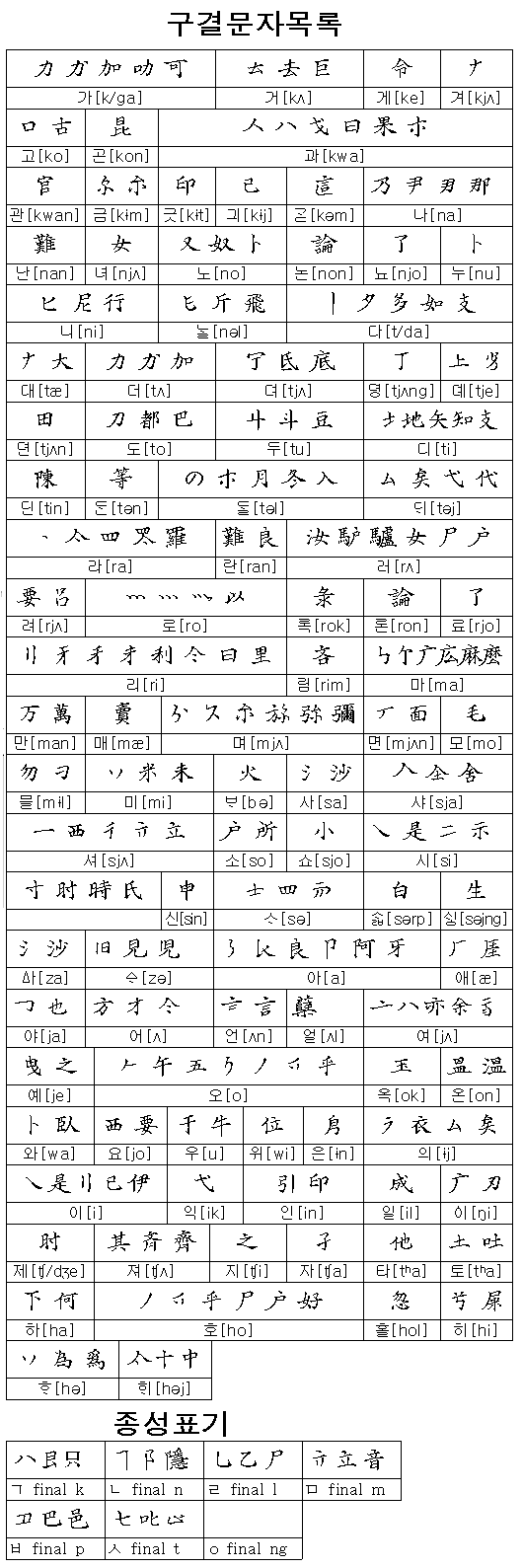Gugyeol
This article shouldspecify the languageof its non-English content, using{{lang}},{{transliteration}}for transliterated languages, and{{IPA}}for phonetic transcriptions, with an appropriateISO 639 code.Wikipedia'smultilingual support templatesmay also be used.(October 2023) |
| Gugyeol | |
| Hangul | 구결 / 입겿 |
|---|---|
| Hanja | |
| Revised Romanization | Gugyeol / Ipgyeot |
| McCune–Reischauer | Kugyŏl / Ipkyŏt |
 |
| Korean writing systems |
|---|
| Hangul |
|
| Hanja |
| Mixed script |
| Braille |
| Transcription |
| Transliteration |
|
Gugyeol,orkwukyel,is a system for rendering texts written inClassical Chineseinto understandableKorean.It was used chiefly during theJoseon dynasty,when readings of the Chinese classics were of paramount social importance. Thus, ingugyeol,the original text in Classical Chinese was not modified, and the additional markers were simply inserted between phrases.
The parts of the Chinese sentence would then be read in Korean out of sequence to approximate Korean (SOV) rather than Chinese (SVO) word order. A similar system for reading Classical Chinese is still used in Japan and is known askanbun kundoku.
Gugyeol is derived from thecursiveandsimplifiedstyle of Chinese characters.
Etymology
[edit]The namegugyeolcan be rendered as "phrase parting" and may refer to the separation of one Chinese phrase from another. This name is itself believed to originate from the use of hanja characters to represent theMiddle Koreanphraseipgyeot(입겿), with a similar meaning.Gugyeolis also sometimes referred to asto(토, phun ), orhyeonto(현토, huyền phun ), sincetois also used to refer to the morphological affixes themselves or asseogui(석의, giải thích ), which can be rendered as "interpretation of the classics."
History
[edit]Gugyeolis first attested from the 11th century in the earlyGoryeodynasty, but evidence indicates it likely dates back to the 7th century or earlier.[1]In this period, certain hanja characters were used (along with specialized symbols) to represent Korean sounds through their meaning. For example, the syllable '잇' (is) was represented with the hanja characterCósince that character has the Korean meaning '있다.' This technique came to be replaced in the late Goryeo period with using hanja characters according to their sound. The later version of thegugyeolsystem was formalized byChŏng Mong-juandGwon Geunaround 1400 in the earlyJoseon Dynasty,at the behest ofKing Taejong.ManyConfucian classics,including theClassic of Poetry,were rendered intogugyeolat the time.
The termgugyeolis often extended beyond this early system to similar uses ofhangulfollowing the introduction of theHunminjeongeumin the 15th century. In this respect,gugyeolremains in occasional use in contemporarySouth Korea,where such techniques are still sometimes used to render the Confucian classics into readable form.
Gugyeolshould be distinguished from theiduandhyangchalsystems, which preceded it.Gugyeolused specialized markings, together with a subset of hanja, to represent Koreanmorphologicalmarkers as an aid for Korean readers to understand the grammar of Chinese texts. Also, theiduand thehyangchalsystems appear to have been used primarily to render Korean intohanja;on the other hand,gugyeolsought to render Chinese texts into Korean with a minimum of distortion.
Table of Gugyeol
[edit]This sectionmay need to beformatted.(March 2022) |
See also
[edit]References
[edit]- ^Vovin, Alexander (2010). "Is JapaneseKatakanaDerived from KoreanKwukyel?".In Lee, Sang-Oak (ed.).Contemporary Korean Linguistics: International Perspectives.Thaehaksa Publishing.ISBN978-89-5966-389-7.
Further reading
[edit]- Kim Mu-rim (김무림) (2004).국어의 역사[History of the Korean language]. Seoul: Hankook Munhwasa.ISBN89-5726-185-0.
- Kwon Jae-seon (권재선) (1989).간추린 국어학 발전사[An abridged history of Korean language studies]. Seoul: Ugoltap.


